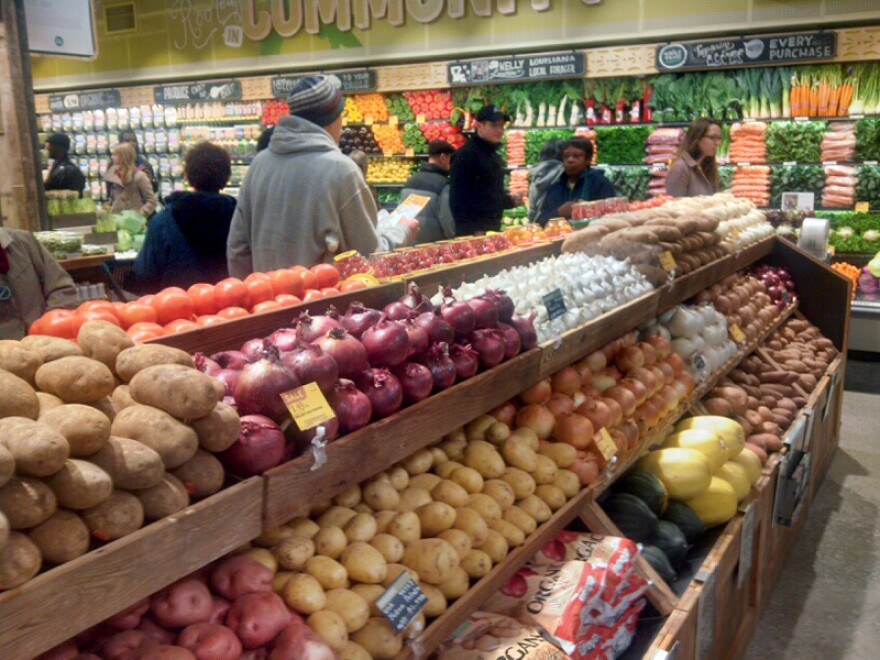A new Whole Foods store opened in Mid-City on Tuesday, at Broad and Bienville. It’s the site of the former Schwegmann’s grocery, which has been vacant ever since Katrina.
The space includes four nonprofit tenants in addition to the Whole Foods. The upscale grocery is just one of many factors reshaping the area.
Ten days before the grand opening of the new Whole Foods, the meeting room at the Sojourner Truth community center was buzzing in anticipation.
Whole Foods leaders and the other tenants of the ReFresh project mingled and answered questions. The developers were hustling hard to show that their project is for everyone in the large and diverse Mid-City area.
The elephant in the room was Whole Foods. The national chain is notorious for its high prices and upscale marketing. Some people wonder: is the Whole Foods market for current residents, or for a new wave of higher income people?

“There’s been a lot of concerns about price and affordability and access, but really this is about making sure that everyone knows that they deserve the opportunity to purchase fresh affordable food, says Leah Berger Jensen, a community health consultant for the ReFresh project. "This is about providing the infrastructure to support that.”
Whole Foods says it can provide that infrastructure because this location is slightly different from its typical store model. Ernest Roy is the manager of the Broad Street location. He explained how the store plans to cater to the area.
“We feel like we’re very price competitive — we do a lot of shopping around to make sure that we are price competitive," he says. "We also have our 365 Value line, conventional and organic. It offers a great value for high quality food. We’ll have value tours to be showing everyone around. We’ll also have two healthy eating educators that will do the value tours, so we can make sure the community understands how to shop on a budget.”
This emphasis on serving low income shoppers goes back to the project’s beginning. It was developed in part as a complement to the new Faubourg Lafitte housing project, which is a few blocks behind the store. L&M Partners is the New York-based company that developed the mixed-income community out of the Lafitte housing project. Lisa Amoss, from Broad Community Connections, says the project happened thanks to tax credits and the developer’s interest in a grocery for their tenants.
“They came to us and expressed an interest in helping us," Amoss says. "We could never have done this project without their help.”

It’s clear that expectations and excitement are high among developers and community leaders, but there’s also an element of risk that’s hard to ignore. The store’s success depends on regular business from all residents. Nolan Crawford lives off of Bienville, just two blocks away from the new Whole Foods.
“The people so far that I’ve talked to, they can’t wait until it opens," Crawford says. "They can’t wait. A lot of them want to go over there and shop — instead of going way across on the other side of town to Winn-Dixie, they can go right there at home,” he says.
Robert McCalvin is the manager of the laundromat across the street from the new store. He says his customers will appreciate the opportunity to grocery shop while their clothes are in the wash. And he’s looking forward to the nutritional variety the store will bring.
“I think it’ll be great, because me personally, I’m sick and tired of Wonder Bread, this, that and the other. I want bread, I want fresh fruits,” he says.
There’s a risk of higher prices, but that could come with higher wages, says India Young. She attends bartending school next door.
“It’s worth it, because actually they pay their employees a decent salary," Young says. "So everybody benefits. I mean, you get what you pay for. If you’re gonna pay cheap you’re gonna get cheap.”
But there remains the question of gentrification and all that it brings, both good and bad. Teddy Bush has owned and operated a barber shop on the corner of Broad and Bienville for 26 years. He says the Whole Foods will be great for the neighborhood in general, but there could be some unfortunate consequences.
“I’ve seen folks move in the area that have never been in the area before, especially on Bienville. That’s one concern of mine, that they’re forgetting about the poor folks,” says Bush.
And there’s absolutely no question that property values are going up. Natalie Lafont has sold real estate in the Mid-City area since 2002.
“I can only speak to what I’m experiencing now: I have a number of lease listings. I can’t get enough of them. People want them. I have a few sales listings that go immediately under contract. People are investing in the area without hesitation,” she says.
At this point, of course, it’s impossible to know exactly how and how much the Whole Foods will impact the community. But one thing is clear: people are curious. As longtime Mid-City resident Lisa Amoss puts it:
“I think everybody sees this as a little lagniappe for living where we live. We’re all really excited.”



